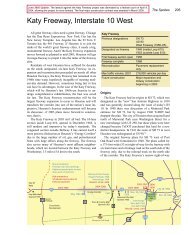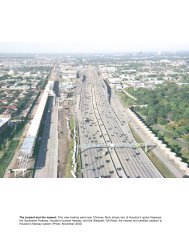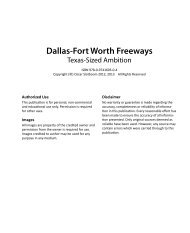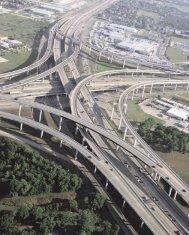June 2005 Update: The US 59/IH-10
June 2005 Update: The US 59/IH-10
June 2005 Update: The US 59/IH-10
Create successful ePaper yourself
Turn your PDF publications into a flip-book with our unique Google optimized e-Paper software.
Downtown Freeways 125Building the Freeways<strong>The</strong> first construction on downtown Houston freewayswas underway by late 1953, consisting of the first phase ofpresent-day <strong>IH</strong> 45 on the western edge of downtown. <strong>The</strong>first freeway section, the main freeway lanes of <strong>IH</strong> 45,opened December 12, 1955. For the next 25 years therewould be a steady progression of work on the HoustonCentral Interchange (see map on page 118 with completiondates). On April 11, 1958, the Eastex Freeway wasextended into downtown with the opening of the BuffaloBayou bridge. <strong>The</strong> Southwest Freeway and its distributionsystem into downtown via Spur 527 were completedon July 26, 1961. On July 24, 1962, <strong>IH</strong> 45 was completedfrom the north side of Houston into downtown, formingthe first phase of the large <strong>IH</strong> 45-<strong>IH</strong> <strong>10</strong> multiplex. <strong>The</strong> <strong>IH</strong>45 interchange structure on the west side of downtownwas also finished in 1962 with the addition of collectorlanes and connector ramps. In April 1966 the <strong>US</strong><strong>59</strong> elevated structure on the east side of downtown wascompleted. Construction of the Pierce Elevated structurewas complete in spring 1965, and it was opened to trafficon August 18, 1967, connecting the North Freeway to theGulf Freeway. On December 20, 1968, the Katy Freeway(<strong>IH</strong> <strong>10</strong> West) was brought into downtown Houston, andthe multiplex interchange with <strong>IH</strong> 45 was substantiallycomplete. On May 17, 1972, <strong>IH</strong> <strong>10</strong> on the north sideof downtown between <strong>IH</strong> 45 and <strong>US</strong> <strong>59</strong> was opened,completing <strong>IH</strong> <strong>10</strong> through Houston and the inner loopof freeways around downtown. <strong>The</strong> last major link in thedowntown freeway system was finished on September 27,1974, with the opening of <strong>US</strong> <strong>59</strong> between Spur 527 and <strong>IH</strong>45. <strong>The</strong> <strong>US</strong> <strong>59</strong>-SH 288 interchange was completed on November20, 1980. With that project, the Houston CentralInterchange was complete. Although major reconstructionof the Gulf Freeway just southeast of downtown wouldbegin in the early 1980s, construction in the immediatedowntown area would go into a state of dormancy forabout the next 15 years.First Came the Freeways, then the SkyscrapersIn the mid-1960s, downtown Houston consisted of amodest collection of mid-rise office structures. By thelate 1960s, most of the freeways into downtown Houstonwere complete and there was greatly improved access todowntown from all parts of the city. In 1970 the regionaltransportation planning group, the Houston-Harris CountyTransportation Study, published a report on the centralbusiness district which stated, “<strong>The</strong>re is less traffic congestiontravelling to or from the Houston central businessdistrict than in any city of comparable size. Comparativetravel time studies conducted in 1960, 1965, and 1969have shown that during the evening peak hours the traveltime has been vastly improved in all directions except forthe Gulf Freeway, although this facility is showing improvementscompared with 1965.” <strong>The</strong> reason for theseimprovements was, of course, the new freeway system. Interms of motorists’ ability to efficiently travel during rushhour, 1970 would later be recognized as the year of peakKey dates in Houston’s downtown freeways1945 Official TxDOT authorization to begin study ofdowntown freeways.1948 Gulf Freeway opens southeast of downtown with anextensive distribution system into downtown streets.1954 <strong>The</strong> general plan for the downtown Houston freewaysystem is finalized as part of an overall freeway planfor the Houston region.1955 First downtown freeway segment opens, a shortsection of <strong>IH</strong> 45 on the west side of downtown.1963 <strong>The</strong> detailed plan for the downtown Houston freewaysystem is finalized.1967 <strong>The</strong> Pierce Elevated section of <strong>IH</strong> 45 opens.1972 <strong>IH</strong> <strong>10</strong> north of downtown opens, completing the looparound downtown.1974 <strong>US</strong> <strong>59</strong> south of downtown opens, completing alldowntown main lanes in the original plan except thecancelled Harrisburg Freeway.1980 <strong>The</strong> <strong>US</strong> <strong>59</strong>-SH 288 interchange opens, completing theoriginally planned downtown freeway system.1997 <strong>The</strong> second wave of downtown construction beginswith rehabilitation work and a large new interchange at<strong>US</strong> <strong>59</strong> and <strong>IH</strong> <strong>10</strong>.2003 Work begins on the complicated reconstruction of theSouthwest Freeway (<strong>US</strong> <strong>59</strong>) downtown approach.2004 Completion of the <strong>US</strong> <strong>59</strong>-<strong>IH</strong> <strong>10</strong> interchange.2007 Scheduled completion of the Hardy Toll Road freewayextension into downtown, almost certainly the last newfreeway for downtown.FuturePotential improvement and expansion of <strong>IH</strong> 45 and<strong>US</strong> <strong>59</strong>.mobility in Houston. <strong>10</strong>It didn’t take long before downtown Houston wastransformed into one of the more impressive skylines inthe United States. In 1960, the central business district had<strong>10</strong> million square feet of office space, increasing to about16 million square feet in 1970. Downtown Houston wason the threshold of a boom in 1970 with 8.7 million squarefeet of office space planned or under construction andhuge projects being launched by real estate developers. *<strong>The</strong> surge of skyscrapers mirrored the skyscraper boomsin other freeway cities, especially Los Angeles and Dallas.Houston’s downtown construction was further fueled bythe 1970s energy industry boom.<strong>The</strong> first major skyscraper to be constructed in Houstonwas the 50-floor, 714-foot-tall (218 m) One Shell Plazain 1971. A succession of skyscrapers were built throughthe 1970s, culminating with Houston’s tallest skyscraper,the 75-floor, 1,002-foot-tall (305 m) JPMorgan ChaseTower (formerly the Texas Commerce Tower), completedin 1982. In 2002 it was the ninth tallest building in the*<strong>The</strong> largest proposed development was the 32-block Houston Center.Only a small part of the original proposal was ultimately constructed.Other large projects included Cullen Center, Allen Center, and towersfor Shell Oil.








